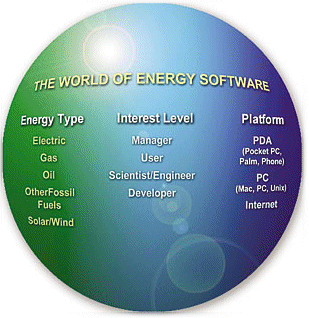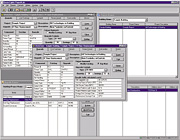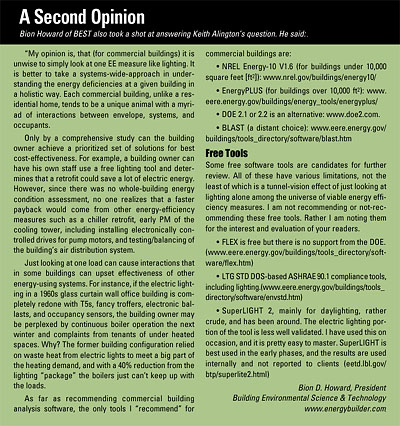Energy Software Tools
By Bill Shadish
Figure 1. Categories of energy software It is everywhere-if you know where to look
Q. Finding energy-related software tools can be confusing. There are literally dozens of places to download or get tools from, some of which cost money and some of which do not. The Department of Energy sponsors some of these and does not sponsor others. While there is plenty of stuff out there, there is no way to really help in choosing between them.I am a building inspector from Billings, MT. I use a laptop in the field to help when inspecting building lighting against local code. My laptop uses Microsoft Windows 2000. I also have a Palm Pilot V.
What do you recommend to help in this endeavor? I am interested in lighting-related tools.
Keith Alington
Field Inspector,
Billings, MT
A. Keith's problem is fairly typical. But the answer is not so simple. It is actually more difficult to think of the best way to attack this question for the general electric inspector than it is to find the sites with appropriate content.
There are a number of ways to look at the available energy software. Figure 1 shows some categories, but there are others, such as:
- Commercial or residential
- Paid or free
- U.S. developed or international
Further, any given type of software, such as a heating cost calculator, can vary greatly depending upon the function it serves. The number of energy software tools is almost immeasurable. But a few rules can be applied to help Keith with his dilemma.
The software should meet the follow basic needs.
- Can be used in the field and not just in the office. This allows both laptop and PDA tools.
- Good for commercial buildings.
- Technician friendly.
- Lighting focus.
- Cost free.
Ten Tools
Figure 2. ProjectKalc.
Some tools are freely available for lighting design and building analysis. Many are available at Web sites. Further descriptive information is available below for about 10 of these many tools and their proper application.In addition, some things that are desirable in software are the ability to:
- Interface with CAD applications (such as Autocad) to create building designs
Easily import and export data Alter the database used by the tools to customize the data that is captured.
1. FLEX (Federal Lighting Energy Expert) v. 3.0: Provides energy, economics, pollution prevention, daylighting, and implementation notes for lighting system retrofits (www.eere.energy.gov/buildings/tools_directory/software/flex.htm).
2.LTG STD ASHRAE 90.1: Helps an inspector to calculate a building's compliance with envelope and lighting system performance against the DOE's energy conservation performance standards for commercial buildings (www.eere.energy.gov/buildings/tools_directory/software/envstd.htm).
3.SuperLIGHT v. 2.0: A lighting analysis program designed to accurately predict interior luminance in buildings. Handles windows, skylights, interior daylight levels, etc. (eetd.lbl.gov/btp/superlite2.html)
4.ProjectKalc v. 3.02: A tool for comprehensive energy and economic analysis of lighting upgrades, including upgrades of controls, relamping, delamping, and tandem wiring (208.254.22.6/index.cfm?c=business.bus_projectkalc.
5.ComCheck-Plus: This tool checks compliance against the commercial building energy code using a whole-building performance method (www.eere.energy.gov/buildings/tools_directory/software/comcheckplus.htm).
6.SkyCalc: SkyCalc is an Excel spreadsheet that is used to arrive at the optimum sky lighting strategy for a building. SkyCalc requires free registration to download (www.energydesignresources.com/tools/skycalc.html).
7.Radiance v. 1.02: Calculates spectral radiance values (illuminance and color) and spectral irradiance (illuminance & color) for interior and exterior spaces. Used to predict illumination, visual quality, and appearance. Integrates with CAD packages to provide energy-efficient lighting building design and daylighting strategies (floyd. lbl.gov/deskrad/download.htm).
8.EQUEST: Tool to calculate a building's energy use and provide design technologies analysis. Includes data entry wizards and graphical results. eQuest requires free registration to download (www.energydesignresources.com/tools/equest.html).
9.PVWATTS v. 1: An interesting look at the future, PVWATTS is a renewable technology tool that calculates PV (photovoltaic) use and performance estimates in a grid-connected system. This application uses an online Internet calculator, which is interesting to consider in its own right (rredc.nrel.gov/solar/codes_algs/ PVWATTS/version1/).
10.ASEAM v 5.0: ASEAM (a simplified energy analysis method) is an evaluation of high-potential, cost-effective energy efficiency projects in existing Federal buildings. Calculates results that are within 5% of DOE-2 annual energy results and is easy to use. (www.eere.energy.gov/buildings/tools_directory/software/aseam.htm)
A Little Bit More "Handy"
These ten tools above are all PC or Web-based applications. There are also a growing number of tools for handheld devices, such as Palm Pilots, Pocket PCs, and even mobile phones. One such example application for a Palm Pilot can help inspectors with simple calculations. The application is available at www.fundamentalobjects.com/qa.Others include:
FormulaCalc v.1.0: This tool provides a math calculator that supports formulae. Functions including square root, if, log, int, sin, degree, rad, etc. are available for use within these formulas. The application can calculate, store (and use within the calculations) up to 26 pieces of information held in different storage locations (www.40-below.com/palm).
The following organizations provide a wealth of lighting-related topics that will assist with lighting inspections.
Lighting Research Center: This site includes papers on lighting metrics, technologies, applications, design, and research items. For commercial lighting topics, see this page in particular: (www.lrc.rpi.edu/researchTopics/applicationsDesign/commercial.asp)
The Basics of Efficient Lighting: This downloadable paper by Rebuild America and Lithonia Lighting provides information on the concepts of efficient lighting, which can be useful in describing the concepts to customers (www.texasenergypartnership.org/e/LithoniaLightingGuide.pdf)
Summary
A number of other software applications can make auditing, inspection, and testing work easier. Touch on the relevant links from time to time -both to see what new things are out there, as well as to see what the competition may be doing.
About the Author: Bill Shadish is a principal of Fundamental Objects, Inc. (www.foaudits.com), where he works on client partnerships, custom energy software, and handheld technology. Shadish writes for a number of industry trade journals; including Home Energy Magazine.Contact him here.
Copyright © 1995-2023 Fundamental Objects, Inc. All Rights Reserved.
< img src="images/eod2.gif" height="17" width="42">


